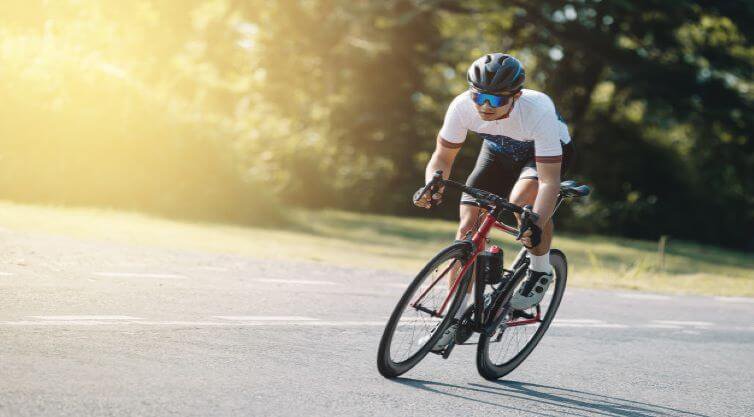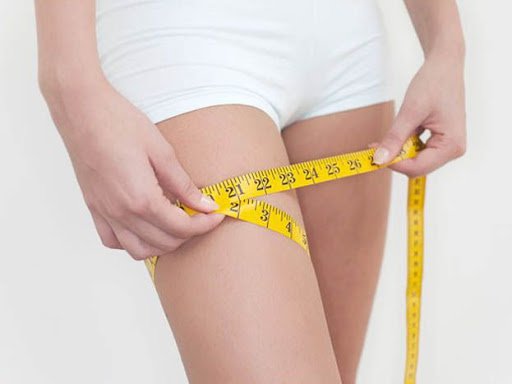How long and how many kilometers should you cycle a day?
This is an automatically translated article.
How long and how many kilometers should you cycle a day? This is a question many people ask when practicing this sport. First, determine what the purpose of cycling is, determine how much cycling you can or must do in a day. Also, it depends on what you want to achieve. The following article will help you figure out how to determine the time and number of kilometers to achieve when cycling.
1. How to practice cycling properly?
Cycling is one of the great ways to exercise for cardiovascular health. An average cycling workout will burn about 400 calories per hour. Plus, it strengthens the lower body, including the legs, hips, and buttocks. If you want a gentle exercise for your back, hips, knees, and ankles, this is a great choice.
We can bike outdoors on roads, bike paths or mountain trails. Indoors, we can also train on a stationary bike or buy a stand, called an indoor exercise machine, for our outdoor bike. If you are a beginner, choose a flat path to ride your bike. When you're ready for more difficult challenges, while focusing on the upper body try cycling on roads with higher inclines. You can also do it on trails and different types of rough terrain. Mountain biking is more difficult because you have to navigate hills and surfaces, so the upper body will be active. It's more of a full-body workout than a road bike - mostly a lower body workout.
Plan to ride 30-60 minutes, 3-5 days a week. Start each ride with a light warm-up. Pedal at a slow, gentle pace for 5-10 minutes. Then, increase the speed to start sweating. If you're riding stationary, just change the settings for a faster pace. When you're ready to get the job done, take another 5 minutes to cool down by cycling at a slower pace.
What can cycling bring? Intensity level: High Cycling increases our heart rate almost as much as jogging and burns a lot of calories. This is also a relatively safe exercise method. It doesn't put much stress on the joints, which is helpful if you're in the process of getting in shape or have joint problems.
We can bike outdoors on roads, bike paths or mountain trails. Indoors, we can also train on a stationary bike or buy a stand, called an indoor exercise machine, for our outdoor bike. If you are a beginner, choose a flat path to ride your bike. When you're ready for more difficult challenges, while focusing on the upper body try cycling on roads with higher inclines. You can also do it on trails and different types of rough terrain. Mountain biking is more difficult because you have to navigate hills and surfaces, so the upper body will be active. It's more of a full-body workout than a road bike - mostly a lower body workout.
Plan to ride 30-60 minutes, 3-5 days a week. Start each ride with a light warm-up. Pedal at a slow, gentle pace for 5-10 minutes. Then, increase the speed to start sweating. If you're riding stationary, just change the settings for a faster pace. When you're ready to get the job done, take another 5 minutes to cool down by cycling at a slower pace.
What can cycling bring? Intensity level: High Cycling increases our heart rate almost as much as jogging and burns a lot of calories. This is also a relatively safe exercise method. It doesn't put much stress on the joints, which is helpful if you're in the process of getting in shape or have joint problems.

Đạp xe giúp nhịp tim của chúng ta tăng gần tương đương với việc chạy bộ và đốt cháy rất nhiều calo
Affected areas Bone and joints: Yes. Your bones and joints will become stronger from cycling. Arms: Nope. This exercise does not specifically target the arms. Legs: Yes. This is a great exercise for the legs, especially the glutes and hamstrings. Buttocks: Yes. The glutes and hips will be seriously exercised by cycling. Back: Nope. This exercise does not specifically target the back. If you want more upper body work, try mountain biking. It will help your back muscles work as you move up and down hills. Type of Flexibility: No. This exercise does not focus on flexibility. Cardiovascular: Yes. Cycling is a good exercise for the heart. Strength: Yes. The large muscles of the lower body will be strengthened when cycling. Sports: Yes, if we are competing in a race. Low impact: Yes. This is an exercise that doesn't put a lot of pressure on the joints. Other things to know Cost: If you don't own a bike, you may have to buy a new or used one. In some places, you can also rent one. Good for beginners? It's correct. Even if we haven't cycled in years, we can get right back to it. If you are overweight, cycling is a good choice because this method can help you lose weight very well. Outdoors: Yes. Cycling is an ideal outdoor exercise. At home: Yes If you have a stationary bike or exercise machine in your home, you can cycle indoors. Necessary equipment? It's correct. You will need a bicycle (go to your local bike shop to get the correct size bike). Helmets are a must for safety. You can also try padded cycling shorts, which can help make riding more comfortable. Gloves can protect your hands from rubbing against the handlebars.

Đi xe đạp là một bài tập luyện ngoài trời lý tưởng
Cycling is also ideal as a cardiovascular exercise. It provides a low-impact workout, while helping to build strong legs and improve cardiovascular health. In fact, anyone can do it. It is very good for beginners. And we can increase the intensity as fitness levels have improved, making it a challenging workout even for advanced lifters.
If you want to ride outdoors but feel a little unsteady, start with indoor cycling to help build some muscle strength for stability while cycling. When you're ready, work out outside, but take it slow at first. Always wear a helmet when cycling outdoors. Head injuries are one of the most common bicycle injuries when people ignore protection.
Since cycling is a low-impact exercise, it is ideal for people with arthritis in the hips, knees and ankles or recovering from a joint injury. In addition, it helps build stronger leg muscles, gives more support to the joints and helps reduce pain. For people with back problems, they can still incorporate cycling into their routine, but need to find another form of exercise to strengthen their joints and make their body more flexible. For pregnant women, focus on indoor cycling. A stationary bike provides stability so pregnant women don't fall.
If you want to ride outdoors but feel a little unsteady, start with indoor cycling to help build some muscle strength for stability while cycling. When you're ready, work out outside, but take it slow at first. Always wear a helmet when cycling outdoors. Head injuries are one of the most common bicycle injuries when people ignore protection.
Since cycling is a low-impact exercise, it is ideal for people with arthritis in the hips, knees and ankles or recovering from a joint injury. In addition, it helps build stronger leg muscles, gives more support to the joints and helps reduce pain. For people with back problems, they can still incorporate cycling into their routine, but need to find another form of exercise to strengthen their joints and make their body more flexible. For pregnant women, focus on indoor cycling. A stationary bike provides stability so pregnant women don't fall.
2. How long and how many kilometers should you cycle a day?
Cycling is not only fun, it's also a great form of aerobic exercise. The habit of cycling regularly for at least 30 minutes a day will help you lose weight and keep fit. We can gain many health benefits through daily cycling, such as cardiovascular fitness, improved joint health, and improved muscle strength and tone. Of course, once we have determined to exercise to get in shape, we should ensure the daily time and distance to achieve the goal. Do a minimum of 150 minutes a week of cycling to stay fit for all ages, or increase your cycling time to 30 to 45 minutes a day to lose weight and reap the many health benefits.

Đi xe đạp không chỉ là sự vui vẻ mà nó còn là một hình thức tập thể dục nhịp điệu tuyệt vời
Experts recommend that adults ages 18 to 64 need at least two and a half hours of moderate-intensity physical activity each week to achieve and maintain good fitness. Cycle for at least 30 to 45 minutes a day to lose weight and get other health benefits. In addition, you should also add strength training exercises at least twice a week. You can meet your daily cycling distance outdoors or use stationary bikes at home or at the gym.
When exercising on a bicycle, you should pedal hard enough to raise your heart rate to a heart-healthy level. Another measure of exercise intensity is heart rate. When starting out, aim for a heart rate between 40% and 50% of your maximum heart rate. Over time, increase this number to 70% of your maximum heart rate. Once you're settled, cycle fast enough when you've completed your daily cycling distance to maintain that heart rate.
For many people, staying fit means keeping the lost weight from coming back. Cycling burns a lot of calories and thus helps with weight control. Counting the calories you burn while cycling along with what you eat is a helpful way to stay on track. The amount of calories you burn while cycling for 30 minutes a day depends on your weight, how fast you ride, and how long you cycle.
For example, if you weigh about 60kg, you burn about 354 calories per hour cycling from 15-18 kg/hour. An 80kg person will burn 490 calories per hour at that cycling pace. At 20-25 km/h and 60kg weight, you burn 590 calories and an 80kg rider will burn 817 calories per hour. For weight management, how much you should cycle each day depends on how many calories you want to burn each week.
Part of staying in shape is minimizing the risk of injury. Cycling for 30 minutes a day strengthens the leg muscles and cardiovascular system, but cycling only limits the development of the upper body. You can achieve better fitness and reduce your risk of injury when you incorporate upper-body strength training exercises. It's also important that you ride with a curvy stance and good shape. Your bike should be properly sized and adjusted to your height and body proportions. That way, you minimize the stress and reduce the risk of injury.
When exercising on a bicycle, you should pedal hard enough to raise your heart rate to a heart-healthy level. Another measure of exercise intensity is heart rate. When starting out, aim for a heart rate between 40% and 50% of your maximum heart rate. Over time, increase this number to 70% of your maximum heart rate. Once you're settled, cycle fast enough when you've completed your daily cycling distance to maintain that heart rate.
For many people, staying fit means keeping the lost weight from coming back. Cycling burns a lot of calories and thus helps with weight control. Counting the calories you burn while cycling along with what you eat is a helpful way to stay on track. The amount of calories you burn while cycling for 30 minutes a day depends on your weight, how fast you ride, and how long you cycle.
For example, if you weigh about 60kg, you burn about 354 calories per hour cycling from 15-18 kg/hour. An 80kg person will burn 490 calories per hour at that cycling pace. At 20-25 km/h and 60kg weight, you burn 590 calories and an 80kg rider will burn 817 calories per hour. For weight management, how much you should cycle each day depends on how many calories you want to burn each week.
Part of staying in shape is minimizing the risk of injury. Cycling for 30 minutes a day strengthens the leg muscles and cardiovascular system, but cycling only limits the development of the upper body. You can achieve better fitness and reduce your risk of injury when you incorporate upper-body strength training exercises. It's also important that you ride with a curvy stance and good shape. Your bike should be properly sized and adjusted to your height and body proportions. That way, you minimize the stress and reduce the risk of injury.

Một phần của việc giữ dáng là giảm thiểu nguy cơ chấn thương
Cycling has long been considered a great sport, bringing many benefits to people's health. Not only supporting the health of the cardiovascular system, skeletal system and increasing muscle strength, cycling is also a very good way to lose weight and maintain a good shape. Do at least 150 minutes a week of cycling to stay in shape, or increase cycling time to 30 to 45 minutes a day to lose weight and get many health benefits.
Please dial HOTLINE for more information or register for an appointment HERE. Download MyVinmec app to make appointments faster and to manage your bookings easily.
Reference sources: livestrong.com, webmd.com
This article is written for readers from Sài Gòn, Hà Nội, Hồ Chí Minh, Phú Quốc, Nha Trang, Hạ Long, Hải Phòng, Đà Nẵng.




